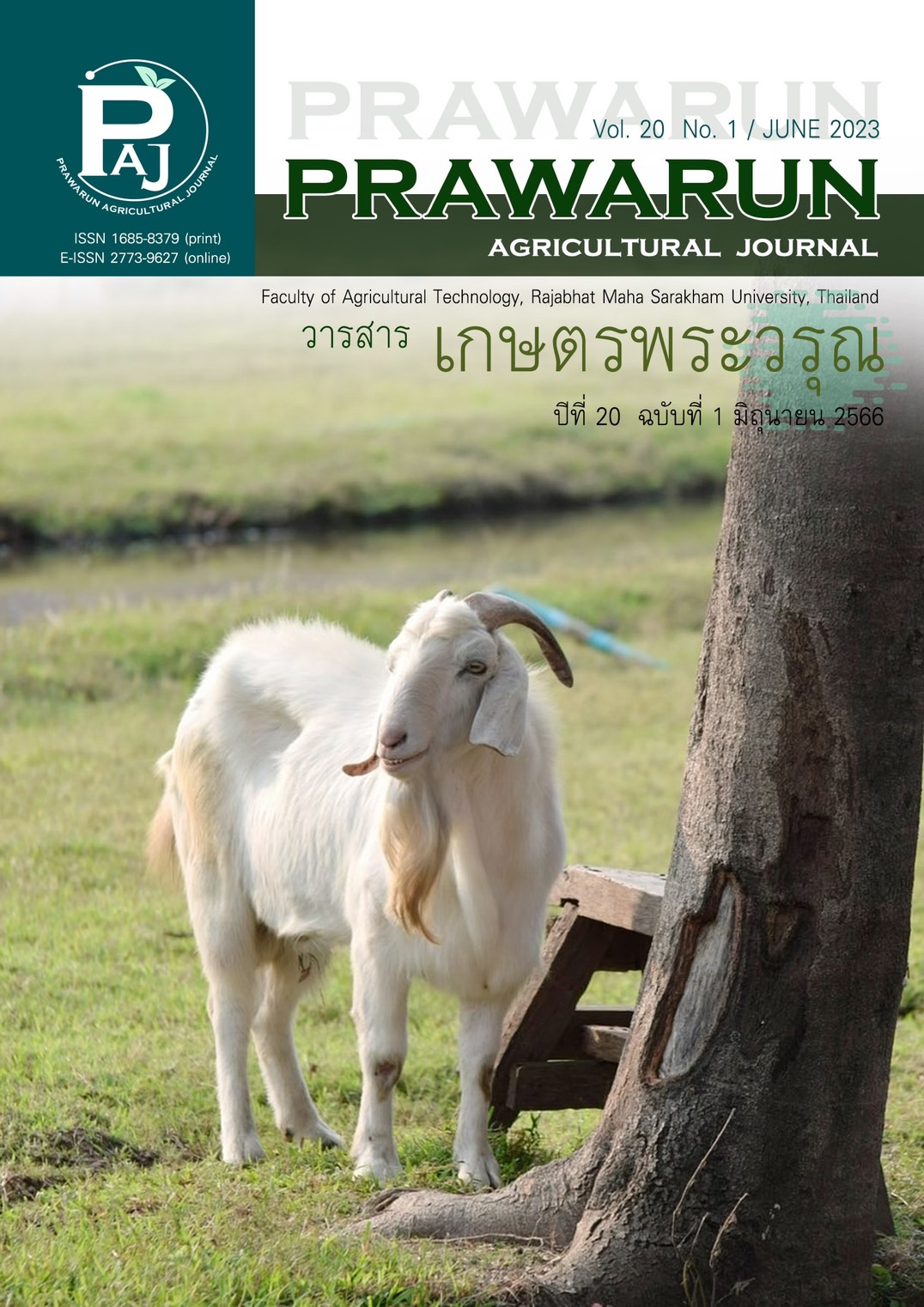ประเมินคุณภาพ ความสามารถในการต้านอนุมูลอิสระและการเกิดออกซิเดชั่นของไขมันในผลิตภัณฑ์เนื้อโคบดอัดขึ้นรูปที่ผสมผงกระเจี๊ยบแดงระหว่างการเก็บเย็น
Main Article Content
บทคัดย่อ
วัตถุประสงค์ของการทดลองนี้เพื่อศึกษาผลของการเสริมผงกระเจี๊ยบแดงต่อคุณภาพ ความสามารถในการต้านอนุมูลอิสระ และการเกิดออกซิเดชั่นของไขมันในผลิตภัณฑ์เนื้อโคบดอัดขึ้นรูประหว่างการเก็บเย็น โดยใช้เนื้อส่วนสันนอก (Longissimus dorsi) มาบดและแบ่งออกเป็น 4 กลุ่ม ๆ ละ 3 ซ้ำ ได้แก่ 1) กลุ่มที่ไม่เสริมผงกระเจี๊ยบแดง (กลุ่มควบคุม) 2) กลุ่มที่เสริมผงกระเจี๊ยบแดง 1 % 3) กลุ่มที่เสริมผงกระเจี๊ยบแดง 2 % และ 4) กลุ่มที่เสริมสาร Butylated hydroxytoluene (BHT) 0.2 กรัมต่อกิโลกรัม โดยเนื้อบดในทุกกลุ่มการทดลองถูกนำมาอัดขึ้นรูปเป็นแผ่นกลมแบน แล้วห่อไว้ที่อุณหภูมิ 4 องศาเซลเซียส เป็นเวลา 0, 5 และ 10 วัน ผลการทดลองพบว่ากลุ่มที่เสริมผงกระเจี๊ยบแดง มีค่าสี L*, a*, b*, Chroma และการสูญเสียน้ำจากการปรุงสุกลดลง และมีค่าความสามารถในการต้านอนุมูลอิสระเพิ่มขึ้น (p < 0.05) เมื่อเปรียบเทียบกับกลุ่มควบคุมและกลุ่มที่เสริม BHT นอกจากนี้ในวันที่ 0 และ 5 หลังการเก็บรักษาเนื้อบด พบว่าการเกิดออกซิเดชั่นของไขมันทุกกลุ่มไม่แตกต่างกัน (p > 0.05) อย่างไรก็ตามในวันที่ 10 หลังการเก็บรักษาเนื้อบด พบว่าการเกิดออกซิเดชั่นของไขมันของกลุ่มที่เสริมผงกระเจี๊ยบแดงและ BHT มีค่าลดลง (p < 0.05) ดังนั้น สามารถสรุปได้ว่าการเสริมผงกระเจี๊ยบแดงอาจมีผลลบต่อสี แต่อาจช่วยทำให้ความสามารถในการอุ้มน้ำดีขึ้น และช่วยยืดอายุในการเก็บรักษาให้นานขึ้น โดยเพิ่มความสามารถในการต้านอนุมูลอิสระและช่วยชะลอการเกิดออกซิเดชั่นของไขมันในเนื้อโคบดอัดขึ้นรูป
Article Details
เอกสารอ้างอิง
AMSA. (2012). Meat colour measurement guidelines. Illinois: American Meat Science Association.
Bendall, J. R., & Swatland, H. J. (1988). A review of the relationships of pH with physical aspects of pork quality. Meat Science, 24, 85-126.
Branen, A. L. (1975). Toxicology and biochemistry of butylated hydroxyanisole and butylated hydroxytoluene. Journal of the American Oil Chemists' Society, 52(2), 59–63.
Clydesdale, F. M., Main, J. H., & Francis, F. J. (1979). Roselle (Hibiscus sabdariffa L.) anthocyanins as colorants for beverages and gelatin desserts. Journal of food Protection, 42(3), 204–207.
Formanek, Z., Kerry, J. P, Higgins, F. M, Buckley, D. J, Morrissey, P. A, & Farkas, J. (2001). Addition of synthetic and natural antioxidants to α-tocopheryl acetate supplemented beef patties: effects of antioxidants and packaging on lipid oxidation. Meat Science, 58(4), 37-341.
Hunter, R. S., & Harold, R. W. (1987). The measurement of appearance. Hoboken, NJ: John Wiley & Sons.
Jung, E. K. Y., & Nami, J. (2013). Roselle (Hibiscus sabdariffa L.) and soybean oil effects on quality characteristics of pork patties studied by response surface methodology. Meat Science, 94, 391-401.
Malelak, G. E. M., Lalelb, H. J. D., Kalea, P. R., & Jelantika, I. G. N. (2017). The sensory properties, color, microbial, lipid oxidation, and residual nitrite of Se’i marinated with lime and roselle calyces Extracts. Media Peternakan, 40(3), 194-201.
Mancini, R. A., & Hunt, M. C. (2005). Current research in meat color. Meat Science, 71(1), 100–121.
Morrissey, P. A., Sheehy, P. J. A., Galvin, K., Kerry, J. P., & Buckley, D. J. (1998). Lipid stability in meat and meat products. Meat Science, 49, S73-S86.
Pastsart, U., Prompakdee, N., & Promtansud, V. (2019). Quality evaluation and texture profile analysis of beef patties formulated with Roselle (Hibiscus sabdariffa L.). Kaen Kaset=Khon Kaen Agriculture Journal, 47(Suppl. 2), 1029-1034. (in Thai)
Riaz, G., & Chopra, R. (2018). A review on phytochemistry and therapeutic uses of Hibiscus sabdariffa L. Biomedicine and Pharmacotherapy, 102, 575-586.
Salleh, M. N., Runnie, I., Roach, P. D., Mohamed, S., & Abeywardena, M. Y. (2002). Inhibition of low-density lipoprotein oxidation and up-regulation of low-density lipoprotein receptor in HepG2 cells by tropical plant extracts. Journal of Agricultural and Food Chemistry, 50(13), 3693-3697.
Sharma, O. P., & Bhat, T. K. (2009). DPPH antioxidant assay revisited. Food chemistry, 113(4), 1202-1205.
Song, F. L., Gan, R. Y., Zhang, Y., Xiao, Q., Kuang, L., & Li, H. B. (2010). Total phenolic contents and antioxidant capacities of selected Chinese medicinal plants. International Journal of Molecular Sciences, 11(6), 2362-2372.
Tarladgis, B. G., Watts, B. M., Younathan, M. T., & Dugan, L. (1960). A distillation method for the quantitative determination of malonaldehyde in rancid foods. Journal of the American Oil Chemists' Society, 37(1), 44–48.
Tsai, P. J., McIntosh, J., Pearce, P., Camden, B., & Jordan, B. R. (2002). Anthocyanin and antioxidant capacity in Roselle (Hibiscus sabdariffa L.) extract. Food Research International, 35(4), 351-356.
Uytterhaegen, L., Claeys, E., Demeyer, D., Lippens, M., Fiems, L. O., Boucque, C. Y., Van de Voorde, G., & Bastiaens, A. (1994). Effects of double-muscling on carcass quality, beef tenderness and myofibrillar protein degradation in Belgian Blue White bulls. Meat Science, 38, 255-267.
Wang, L., Guo, H., Liu, X., Jiang, G., Li, C., Li, X., & Li, Y. (2019). Roles of Lentinula edodes as the pork lean meat replacer in production of the sausage. Meat Science, 156, 44-51.
Wu, H. Y., Yang, K. M., & Chiang, P. Y. (2018). Roselle anthocyanins: antioxidant properties and stability to heat and pH. Molecules, 23(6), 1-13.
Yao, Y., Sang, W., Zhou, M., & Ren, G. (2010). Phenolic composition and antioxidant activities of 11 celery cultivars. Journal of Food Science, 75(1), C9-C13.
Zahid, A., Seo, J. K., Park, J. Y., Jeong, J. Y., Jin, S. K., Park, T. S., & Yang, H. S. (2018). The effects of natural antioxidants on protein oxidation, lipid oxidation, color, and sensory attributes of beef patties during cold Storage at 4oC. Korean Journal for Food Science of Animal Resources, 38(5), 1029–1042.


